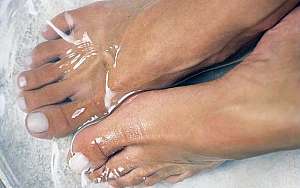How To Treat Plantar Fasciitis At Home
Published: Jan 26, 2015 | Troy Andrews

For the last several weeks I've been experiencing extreme foot pain in the morning. The first few steps out of bed were so painful that I immediately had to sit. At first I thought maybe I broke a bone in my foot. As the day went on, the pain would eventually fade away. Normally when I injure myself in the gym I can expect the pain to last 3-7 days. In my case it had been weeks. So I went to see my Doctor and he diagnosed me with a condition called Plantar Fasciitis. I was relieved that it wasn't a broken bone, he told me the severity of the condition and the consequences of not properly treating it. I want to share my experience to help others who may read this.
What is Plantar Fasciitis?
Plantar Fasciitis is defined as an inflammation of the plantar fascia. The plantar fascia is a ligament structure that supports the longitudinal arch of the foot. The plantar fascia is made from a tough, fibrous band of connective tissue which extends from the ball of the foot to the heel bone. The pain of plantar fasciitis is caused by collagen degeneration associated with repetitive micro tears of the plantar fascia. People who are prone to develop Plantar Faciitis are those with flat feet, athletes, individuals with chronic foot problems and new studies have found that people who have desk jobs are also prone to develop plantar fasciitis because they don't have the opportunity to walk and stretch their plantar fascia throughout the day.
Plantar fasciitis can be very painful in the morning. The first few steps you take out of bed can be excruciating. In most cases plantar fasciitis can be treated without the need of surgery. Those who experience sharp heel pain at the end of the day should seek professional help as soon as possible as this is a sign of severe plantar fasciitis and can lead to greater problems if ignored.
Plantar fasciitis is a self-timing condition. This means that if treated properly the pain will go away. However it is important to know that the average time of treatment is 6 to 18 months. Treating plantar fasciitis at an early stage will decrease the treatment time. If you have been diagnosed with plantar fasciitis it is very important that you properly stretch the plantar fascia ligament. You should perform stretching exercises in the morning and before you go to bed each night.
Why so much pain in the morning?
A big question from plantar fasciitis sufferers like myself is why is the pain so extreme in the morning. The pain associated with plantar fasciitis is caused by the plantar fascia being strained. When you sleep at night your blankets tend to push your feet down. This causes your ligament to essentially "shrink." Your plantar fascia will tighten up and in the morning when you step out of bed and take your first few steps suddenly you stretch your inflamed plantar fascia and you will experience severe pain until the ligament has time to stretch.
What can be done to prevent plantar fasciitis?
Sleep is obviously essential, and your blankets are no exception. My doctor had me wear a plantar fasciitis night splint for several weeks. The plantar fasciitis night splint is worn while you sleep in bed. The night splint will keep your plantar fascia in a stretched position which will help you treat your plantar fasciitis. It is important to treat your plantar fasciitis while your symptoms are only minor. As I have explained, this is a condition which will worsen over time if not treated. If heel pain has become a part of your daily routine then there is a very good chance you have plantar fasciitis.
Treatment plan
If you have already visited your doctor regarding your heel pain and you have been diagnosed with plantar fasciitis you will probably undergo a similar treatment plan.
Evaluation of the cause - This is important in determining why you are developing plantar fasciitis. Perhaps you are training incorrectly, you are stressing your ligaments too much, you have a low arch or no arch at all on your foot, etc. It is important to understand the cause before you begin treatment.
Rest - Rest is important because it will relieve stress on your plantar fascia. Doctors agree that rest is essential for a complete recovery of plantar fasciitis. Your doctor will tell you to stay off your feet and take it easy for a few days or even weeks.
Shoes - Sometimes the type of shoe you wear can actually be the cause of your plantar fasciitis. When you purchase shoes always be sure they they fit properly and that they provide plenty of support and cushioning. Nice running shoes will cost you more but they are designed to take pressure off your plantar fascia ligament.
Ice - Like all other ligament or soft tissue injuries, ice is a great treatment. After an activity ice down your heel and the bottom of your foot to decrease the inflammation of your plantar fascia.
Stretch and Strengthen - The next phase is to strengthen and stretch your plantar fascia so that you can prevent another relapse of plantar fasciitis. By strengthening your plantar fascia you will decrease the risk of developing plantar faciitis again.
Night Splints and Orthotics - Plantar fasciitis night splints should be worn at night to help prevent and treat plantar fasciitis. Although it can be annoying wearing a splint in bed, this will prevent that horrible morning pain your plantar fasciitis is causing you. Your body heels when you rest, night splints will prevent further damage to your plantar fascia while you sleep.
Surgery and Anti-inflammatory Injections - If none of the above methods work then you will probably need to consider surgery or take an anti-inflammatory injection directly into the ligament. Remember that ligaments are slow healing tissues that can take up to 18 months to properly heal.
Published: Jan 26, 2015 By: Troy Andrews








